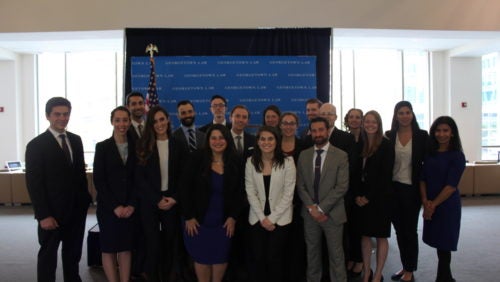Four Cases, Three Circuits, Three Weeks
June 4, 2018

Spring 2018 Appellate Litigation Clinic students with Professor Erica Hashimoto and Fellow Anjali Prakash (LL.M.’22)
Georgetown Law’s Appellate Litigation Clinic is often compared to a boutique appellate firm, with Clinic Director Erica Hashimoto (L’97) as senior partner, one or two Fellows as junior partners, and 16 third-year law students acting as closely supervised associates.
But even a well-seasoned firm might have blanched at the clinic’s pace this spring, when the students argued four cases in three weeks, in three different federal appeals courts, followed by a fifth argument a month later.
“I can’t remember anything like it, and I’m glad I wasn’t the one to have to do it,” said Professor Steven Goldblatt (L’70), who led the clinic for more than 30 years before bringing Hashimoto in as co-director in 2016. Goldblatt took Of Counsel status in August 2017.
“Erica has the youth and the energy to take it on, along with the advocacy and teaching skills,” he said.
As a 3L, Hashimoto had been a student in Goldblatt’s clinic. A dozen years later, after gaining tenure at the University of Georgia School of Law, she sought his advice about starting a similar program there.
She founded UGA’s Appellate Litigation Clinic in 2010 and convinced the Atlanta-based 11th U.S. Circuit Court of Appeals to adopt a student-practice rule. When she returned to Georgetown in 2016, “I brought the 11th Circuit with me,” she said.
The 11th Circuit assigned two of the 11 cases the clinic handled this year, including one that Nicole Pacheco (L’18) argued in Miami on April 10. Before that, Jennifer Safstrom (L’18) had argued in the Fourth U.S. Circuit Court of Appeals on March 20, and Harry Phillips (L’18) and Dominique Rioux (L’18) argued in the U.S. Court of Appeals for the District of Columbia Circuit on March 26 and April 6, respectively. Finally, the D.C. Circuit heard from Caleb Redmond (L’18) on May 17.
Hashimoto also argued a case in February, and a former Fellow argued one last fall, for a total of seven arguments this year.
“I didn’t get much sleep,” Hashimoto said.
The student arguments required coaching as well as 25 or more “moots” by professors and practitioners outside the clinic — in addition to moots by teammates, other clinic students, Hashimoto and Fellow Anjali Prakash.
Several faculty members “were incredibly generous with their time,” Hashimoto said. These included Goldblatt, Professor David Vladeck (who “read every brief we filed and mooted every student who argued,” Hashimoto said), Professor Paul Smith, and Professors Irv Gornstein and Dori Bernstein, the executive director and director of Georgetown’s Supreme Court Institute.
Hashimoto also enlisted attorneys Ruthanne Deutsche (L’04, LL.M.’16) of Deutsche Hunt; Roy Englert Jr. of Robbins, Russell, Englert, Orseck, Untereiner & Sauber; Jeff Lamken of MoloLamken; Howard Srebnick (L’89) of Black, Srebnick, Kornspan & Stumpf in Miami; Cate Stetson of Hogan Lovells; and Vivek Suri of Jones Day.
Having a student argue is more pressure than arguing the case yourself, Goldblatt said. “They have to be so well prepared, at a point in their career when they have no business being up there,” he said. “Some lawyers go their whole career without arguing in federal appellate court.”
Experience
Despite the tight schedules and heavy workload, none of the arguing students reported feeling shortchanged.
“I felt abundantly supported,” said Rioux, reflecting the students’ consensus. “Everyone was so generous … I got greedy about asking for people’s time and input.”
Being part of an argued case also sharpened the skills of the students who weren’t arguing, said Joe Flanagan (L’18), who was on a team with Phillips and Vetone Ivezaj (C’13, L’18). Flanagan said he had to “pinch himself” to believe his good fortune at being part of the process.
On the day Phillips argued, former Solicitors General Donald Verrilli Jr. and Paul Clement (F’88) were arguing different sides of another appeal, just down the hall.
“Had it been another day, I would have gone to watch,” Phillips said. Flanagan, though, went through security behind Clement that morning, noting that he was “just another guy in the bag-check line.”
In briefs and in argument, a student’s performance “needs to be indistinguishable from a seasoned practitioner – and they are,” Vladeck said. “The circuit courts don’t assign lawyers for easy cases; they assign cases when they’re troubled by difficult questions, and they rely heavily on counsel to help them sift through and answer those questions. It’s a testament to Steve and Erica that we get so many assigned cases.”
Goldblatt, though, said he will take credit only for structuring a smooth transition. He called Hashimoto “a rare combination of a scholar, a very skilled lawyer, a very skilled teacher, and deeply committed as a person.”
He noted that Hashimoto received several awards for excellence at the University of Georgia, including one that was presented on the field at halftime during a Bulldogs football game. That award “was a big deal,” Hashimoto confirmed.
Hashimoto’s scholarship received the highest accolade on May 14, when Justice Ginsburg quoted her article, “Resurrecting Autonomy: The Criminal Defendant’s Right to Control the Case,” in the majority opinion in McCoy v. Louisiana.
It’s happened before, Hashimoto said. The Court discussed her first scholarly article at oral argument and cited it in Indiana v. Edwards (2008).
Asked what she considers her greatest honor, she diplomatically demurred, saying it would depend on the observer.
“As to what is the most gratifying for me? It is the day to day. Watching my students grow and do spectacularly well,” Hashimoto said. “Watching my students brief and argue their cases this year has been incredibly gratifying.”